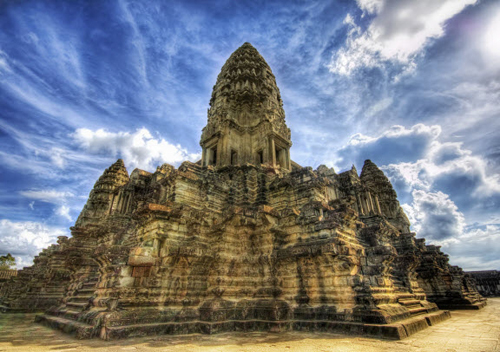By Dipika Kohli
Northwest Asian Weekly

Our giant French doors are open today. There aren’t many other things in the room to distract, but even if there were, the balcony and the white rain beyond it command all of one’s attention. It looks and sounds like a television set that’s always on with loud static and no picture.
Ceilings are high here, and there tend to be second-floor mezzanine levels in most buildings in the city. But in this tiled room of our new Phnom Penh apartment, the double-hinged doors are the most exquisite feature.
Up on the third floor, just by opening them half an inch, you’ll get a flood of the flavor and buzz below, especially at breakfast time when stalls go up for the on-the-way-to-work crowd, and again in the evenings, when the same people are on their way home. It’s all here — sugar cane juice stops, peanuts, coconuts, papaya salads, fried noodles, chicken on a stick.
As commerce stirs, it’s nice to have this room for respite. The patterns on the doors are especially exquisite — Khmer style, in a scheme I’ve been quietly admiring from a distance these past three months. In an article about the world history of design by former University of Illinois art history professor Victor Margolin, there is lament that most of what we know of artists from non-Western countries is limited to ancient traditions. A trap many historians of art and architecture have fallen into, he says, is that of treating “cultures outside the Western mainstream as primitive, traditional, or exotic.”
Maybe that’s why I like the doors so much. And the book. A heavy, oversized hardcover about the design aesthetic of the Khmer people, specifically “kbach” ornament design, is part of the library in the shop on the first floor of our new place. The book describes and gives context to the geometrical patterning you see on government documents, visa stamps, letterheads, logos, and more. Shifting its pages opens a new perspective on how Cambodian people of the past have looked at the world and shaped its beauty in precise lines and curves. Buds, leaves, curls, and crowning crests inspired by natural shapes and small creatures are part of the visual story.
I happened to have brought with me from America a three-piece plastic orange set of French curves. It’s looking like these will come in handy in sketching with local designers and artists. I want to learn from them.
A contemporary aesthetic is emerging here — one can feel it palpably — but it’s yet unclear what direction this will take. “Emerging market” is on the lips of almost every business-minded expat, and it’s true, even though the place is too small for the giant corporations to make money (according to an international brand specialist who was vacationing here from Singapore), that something is abrew. Whatever Cambodia becomes from this point forward, I’m almost positive it will be influenced by the returnees, those who fled ahead of the Khmer Rouge’s reign, and who settled in Europe and North America. Partly from guilt, I suspect, but maybe more out of hope, they’re coming back now, with foreign-born children who wear gel in their hair and are setting up French-style bistros or Danish-influenced schools, and more. So much is about to happen here, and that ripe feeling is what you sense in a whisper when the doors open just a little bit more.
But for now, it’s nice to have some space to observe what’s here. Really here, not just in a book about Cambodia that will tend to show too many “poverty pictures,” and not enough of what it — really — is.
The new history is coming and it’s going to be important to pay close attention if we are to record the conversation in full. Superficial tweets or social shares elsewhere, and stories about this part of the world tend to focus way too much on do-good sorts of things and less on what’s actually starting to look like a smart, sophisticated, and exciting whirl of an “anything can happen” style and culture. Young people are open. They welcome the new. (end)
Dipika Kohli writes at www.kismuth.com.



